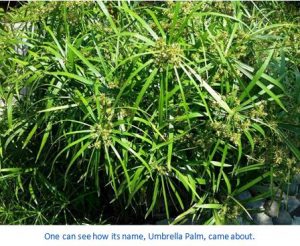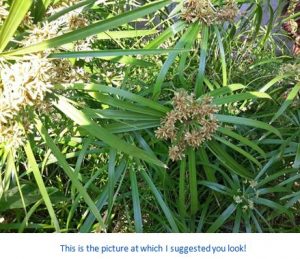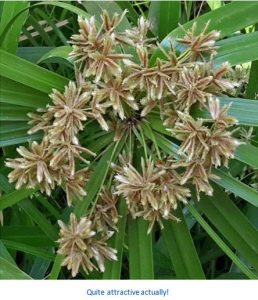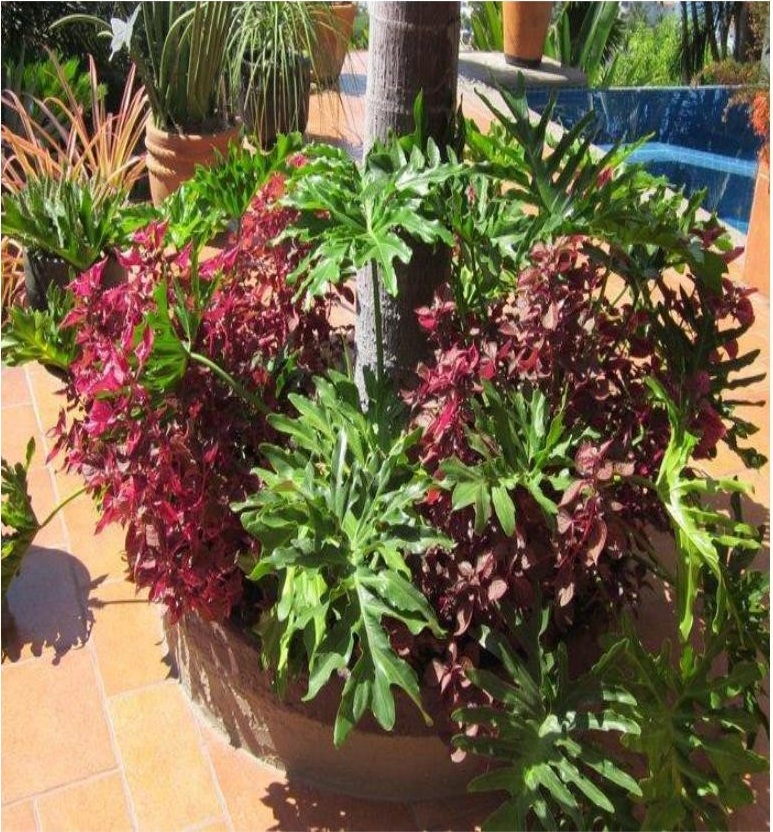By Tommy Clarkson from the August 2017 Edition
Umbrella Palm Cyperus involucratus
Family: Cyperaceae
Also known as: Umbrella Plant, Umbrella Sedge, Umbrella Papyrus, African Sedge, Dwarf Papyrus Grass, False Papyrus, Flat Sedge, Umbrella Flatsedge, Windmill Sedge or Galingale
Of the some 600 herbaceous, sedge species that comprise the Cyperus family, two are rather commonly known. The first is the Cyperus papyrus (from whence came the original parchment “paper” and out of which the tiny boat was made in which the infant Moses was purportedly placed and set adrift on the Nile). The second, with a bit less of a dramatic history, is the Umbrella Palm or, as many call it, the Umbrella Plant.
But, there is some (to coin a word) “muddlement” as this widely cultivated Cyperus involucratus, from Madagascar (Malagasy Republic), is often confused with and misidentified as the tropical Cyperus alternifolius. Yet others know it as the Dwarf Papy-rus (Cyperus alternifolius ‘Gracilis’) while other botanical writers also call the Umbrella Plant (not palm) or the Drain Flat-Sedge (Cyperus eragrostis). (I get so confused!)
 “Wait a minute. Slow down and back up, Tommy. Besides all of those “look-like” and “confused-with” plants, you just sort of slipped over that one thing. Just what exactly is a Sedge as mentioned in that first line?”
“Wait a minute. Slow down and back up, Tommy. Besides all of those “look-like” and “confused-with” plants, you just sort of slipped over that one thing. Just what exactly is a Sedge as mentioned in that first line?”
One can see how its name, Umbrella Palm, came about.
For readily obvious reasons, the Umbrella Palm is appreciated for its attractive, umbrella-like foliage. These “umbrella frames” grow atop, anywhere from eight to twenty-five, triangular, leaf-less stems with – as W. Arthur Whistler so aptly describes in his book Tropical Ornamentals – “terminal, tightly spiraled, leaf-like bracts, and dense inflorescences of brown spikelets.”
The true leaves are actually the long sheaths that cover the bases of the stems. However, the very large leafy inflorescences are actually bracts that are clustered below the seed-heads and are, by many, confused for leaves. The rigid, hairless, upright stems of .12 to .20 of an inch (3 – 5 mm) thick are triangular to almost cylindrical in cross-section.
Rising from woody rhizomes, the Umbrella Palm can grow up to six and a half feet (1.83 – 1.98 meters) tall. The inflorescence has a tight flat spiral of eight to twenty-five leaf-like rays of ten to twenty-four inches (25.40-80.96 cm) by one-quarter to three-quarters (.64 – 1.91 cm). It has six to thirty, year-round flowering, spikelets – isn’t that as fun word? – 1/8 to 3/8 inch (.32 – .95 cm) long displayed in large branching cormybs (short, flat-topped inflorescences) four to twelve inches (10.16 – 30.48 cm) across. The three-sided, achenes (that’s Greek for seeds or nuts) are yellowish or brown and a bit oval-shaped. They are about .04” (1 mm) long and have a beaked apex (projection at the tip) of about (1 mm) long.
If the preceding paragraph is as confusing to you as it is to me, I think it’s probably best if you simply look at the accompanying pictures!
the accompanying pictures!
Remember the array of wetlands in which they can easily proliferate? In numerous locales it’s now considered an invasive plant!
Some folks like to plant these beneath large banana trees. Ours, here in Ola Brisa Gardens, are planted in the same bed with Cyperus papyrus, Cyperus alternifolius ‘Gracilis’ and a small cluster of Lipstick Palm (Cyrtostachys renda) that just can’ t quite decide whether it wishes to be there or not!
This is the picture at which I suggested you look!
As might be expected, like its kin, the Cyperus involucratus pre-fers fertile, wet soil with lots of sunshine. If it’s not growing directly in water, or very close to it on a bank, regularly water it – amply – so as to ensure its roots have a consistent amount to drink. Keep the soil mulched, working new material in as the old decomposes. It will also be most appreciative of spring, summer and fall fertilization of a general, all-purpose sort.
The Umbrella Palm clumps will slowly spread but will benefit from occasionally being cut back to ground level. Cut out dead stalks and, should you choose to do so, you can divide them in the spring with the emergence of new shoots.
But watch out. If allowed to “escape”, it can become a nuisance.
Quite attractive actually!
In simple synopsis, this might be nice for your garden!
Download the full edition or view it online
—
Tommy Clarkson is a bit of a renaissance man. He’s lived and worked in locales as disparate as the 1.2 square mile island of Kwajalein to war-torn Iraq, from aboard he and Patty’s boat berthed out of Sea Bright, NJ to Thailand, Germany, Hawaii and Viet Nam; He’s taught classes and courses on creative writing and mass communications from the elementary grades to graduate level; He’s spoken to a wide array of meetings, conferences and assemblages on topics as varied as Buddhism, strategic marketing and tropical plants; In the latter category he and Patty’s recently book, “The Civilized Jungle” – written for the lay gardener – has been heralded as “the best tropical plant book in the last ten years”; And, according to Trip Advisor, their spectacular tropical creation – Ola Brisa Gardens – is the “Number One Tour destination in Manzanillo”.




